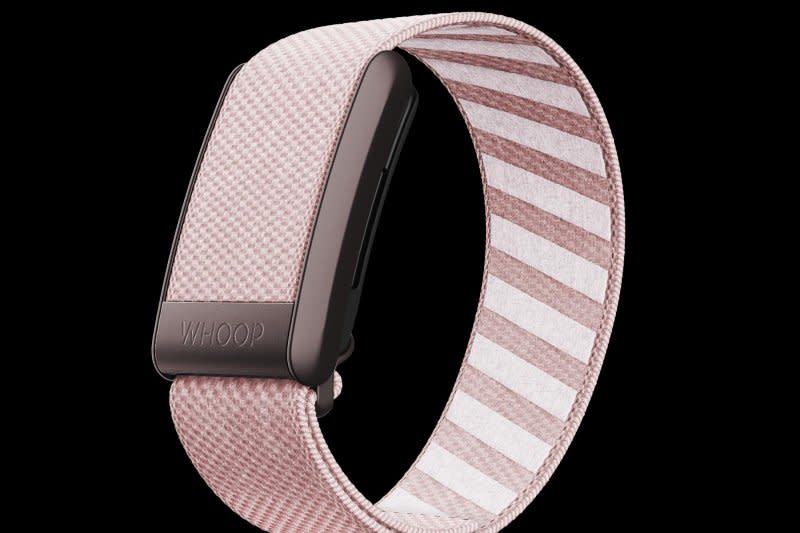Wearable devices may predict preterm births, study says

NEW YORK, Jan. 31 (UPI) -- A noninvasive wearable device may be able to predict preterm births by monitoring changes in maternal heart rate variability, a new study suggests.
The peer-reviewed study was published online Wednesday in the peer-reviewed journal, PLOS One.
Manufactured in Boston, the wearable device studied, the WHOOP 4.0 Strap, is commercially available and provides continuous physiological data, including heart rate variability for a range of applications.
"Despite considerable health consequences from preterm births, their incidence remains unchanged over recent decades," the study's authors wrote, citing limited screening methods as one reason.
They pointed out that this wrist-worn strap represents a novel way to continuously track vital signs, such as maternal heart rate variability, to potentially alert health care providers of increased prematurity risk. This variability differs in preterm and term births in singleton pregnancies.

"The discovery that vital signs during pregnancy may provide an early indication of term length has the potential to transform prenatal care by providing greater insights to expecting parents," the study's corresponding author, Emily Capodilupo, told UPI via email.
In the study, the authors noted that "the ability for continuous passive monitoring becomes especially important for pregnancies in medically underserved areas and obstetric deserts where prematurity is known to have comparatively worse outcomes than areas with abundant obstetric resources."

But regardless of proximity to obstetric care, most preterm labor doesn't have any early indications and prematurity risk isn't routinely screened.
As a result, many women who would benefit from life and cost-saving interventions, such as corticosteroids and magnesium to speed up pulmonary and nervous system development, do not receive these medications in a time frame that would allow for productive intervention.
The manufacturer pointed out, however, that the strap is not an FDA-approved medical device for diagnosing disease or illness and should not be used as a substitute for professional medical advice.
For this study, researchers collected data remotely via noninvasive wearable technology, which enabled diverse participation with subjects representing 42 U.S. states and 16 countries.
A total of 241 participants were retroactively identified from the Whoop Inc.'s userbase and wore WHOOP straps during singleton pregnancies between March 2021 and October 2022.
In analyzing the physiological data, the company found that in singleton pregnancies, maternal heart rate variability trends invert seven weeks prior to delivery. Understanding this change has the potential to save lives and reduce medical costs while fulfilling the desperate need to guide expecting parents, said Capodilupo, senior vice president of data science and research at WHOOP, which makes wearable technology.
However, the authors pointed out that "future prospective studies are needed to determine whether preterm delivery can be predicted in real time at the individual level using wearable technology."
Meanwhile, increasing evidence suggests that physical activity and nutrition-based interventions targeting modifiable risk factors could reduce the risk of preterm delivery. Changes to sleep and exercise also could affect maternal heart rate variability.
The United States' singleton preterm birth rate is 8.42%, with complications related to preterm delivery leading to increased morbidity and mortality along with an economic toll of $25.2 billion annually, according to the study.
Dr. Ann Anderson Berry, neonatology division chief at the University of Nebraska Medical Center in Omaha, who was not involved in the research, said that the study's significance lies in addressing "a complex and consequential problem, preterm delivery, that has long lasting implications for infants and their families and a huge financial burden in the U.S. every year."
Berry said it was a well-designed clinical study of retrospective data from a commercially available sleep, heart rate and fitness tracker.
"The number of pregnant subjects was adequate to describe preliminary data with interesting associations between heart rate availability and preterm delivery," she said.
"There are very limited, accurate measures for early screening of preterm birth, especially spontaneous preterm birth, and yet the consequences of unfortunate, long-term health effects can be quite significant," said Kimani C. Toussaint Jr., senior associate dean for research and strategic initiatives in the School of Engineering at Brown University in Providence, R.I.
"Also, at least in the U.S., there seems to be a racial disparity when it comes to this condition. Thus, the potential to use heart rate variability, obtained from a wearable device, as a possible indicator for preterm birth is really exciting," said Toussaint, who also is director of the Brown-Lifespan Center for Digital Health.
Newborn mortality continues to rise in low-, middle- and high-income countries. And preterm birth is the largest cause of mortality in children under 5 years old, said Nima Aghaeeepour, an associate professor of anesthesiology, perioperative and pain medicine and of pediatrics at Stanford Medicine in Palo Alto, Calif.
However, the study doesn't answer the important clinical question of whether using a wearable digital device can predict preterm birth, said Dr. Kelly Bennett, director of the maternal fetal medicine division and a professor of obstetrics and gynecology at Vanderbilt University Medical Center in Nashville.
"The authors propose that digital device this could allow for the use of other screening tests such as fetal fibronectin, a protein made during pregnancy, and cervical length to identify a potential patient who might require treatment with magnesium, corticosteroids and progesterone for the purpose of preventing preterm birth," Bennett said.
"Unfortunately, progesterone is not an effective treatment for preterm birth and is no longer routinely used for this indication."

